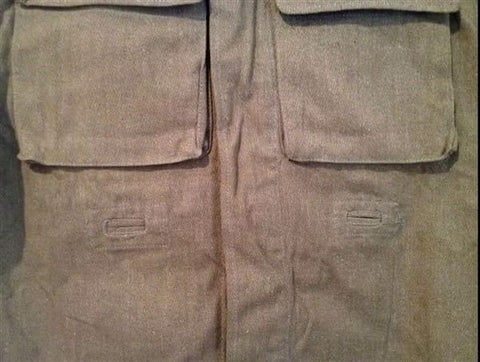The History of the Soviet Afghanka Uniform: A Guide to Assembling Your Own Afghanka M88 Uniform for Afghan reenactment
The History of the Soviet Afghanka Uniform: A Guide to Assembling Your Own Afghanka Uniform for Afghan reenactment

The uniform of 1969 did not meet the modern military requirements, leading to the decision to develop a new uniform in the mid-1970s. The basis for creating the Afghanka was the OKZK-D, a paratrooper general-purpose uniform developed in the late 1960s and early 1970s.

The OKZK-D had two variants – an early version until the mid-1970s and a late version. The early version featured two chest pockets, two hand pockets, and two openings for attaching suspenders. The trousers included two front pockets, two side pockets, reinforced knees, belts, two back pockets, and reinforcement on the buttocks. The jacket was tucked into the trousers, and suspenders were worn under the jacket.



The late version of the OKZK-D saw some changes. The peculiar suspenders from the early version disappeared, but a piece from a Telnyashka was added around the neck area. The trousers remained mostly the same, except for the removal of the rings for suspenders due to their unnecessary nature.


Later, the experimental version of the Afghanka emerged. The distinctive features of the experimental Afghanka included only one pocket on the left sleeve, Velcro fasteners on the chest pockets, and two rows of buttons on the lower pockets. The internal pockets had flaps and were made from water-resistant materials, with two pockets at the back of the jacket.


On the trousers, two pockets had two rows of buttons. In the experimental conditions of the Soviet Union in 1982, Afghankas began to be produced with slight modifications.

The forage cap was borrowed from the border troops of the 1976 model. The cap had two buttons for fixation on top and eyelets for ventilation. In 1988, the ventilation eyelets were moved forward to allow ventilation even with the ear flaps fastened up.


The jacket had 2 pockets on the chest, 2 pockets on each sleeve, and closed with Velcro. It also featured reinforcements on the elbows and cuffs with buttons. There were four ventilation holes under the armpits. In the back part of the jacket, there was more material, colloquially referred to as "Garmoshka," providing more freedom of movement.

The trousers had pleat seams for convenient storage, two regular pockets, two side pockets, and a small pocket on the front for a personal medallion. The belt had two rows of loops for officer and soldier belts. There was a waist adjustment with buttons at the back. The material was reinforced on the knees.
Mass production of such uniforms started in 1985.
In 1984, the introduction of camouflaged Afghankas for the Airborne Troops (VDV) and Marine Infantry in the Butan camouflage pattern marked a significant shift, leading to a clear division.

For the Marine Infantry, the summer field uniform in the Butan camouflage was constructed in the same style as the sandy Afghanka, following the TU-17-08-172-82 standard.
However, the VDV's Afghanka Butan took a different route with three distinct types, each reflecting various design modifications depending on the year of production.

The first type, emerged in 1983. The VDV's Butan Afghanka of the first type was manufactured from 1984 to 1989, lacking shoulder straps for epaulettes on the jacket. It retained the same cutouts for suspenders as the initial sandy Afghanka, as paratroopers favored the older version with suspenders.
The trousers of the first type featured suspenders.

The 2 type of VDV uniform was produced from 1989 to 1990, introducing shoulder strap loops on the jacket.
The 3 type, produced from 1990 until victory, no longer had cutouts for suspenders, and accordingly, suspenders were not present.

Types 1 and 2 were exclusively produced in the Butan camouflage pattern, while the third type was available in both Butan and Barvikha camouflage patterns. This diversification marked a significant evolution in the design and production of the Afghanka uniform for the VDV, adapting to the changing needs and preferences over the years.


Winter Afghanka
The Winter Afghanka came in two variations – sandy and Butan camouflage, with an additional airborne (desantny) version.

What distinguishes the general-purpose greatcoat from the airborne one? In the general-purpose greatcoat, the pockets on the sleeves are patch pockets, while in the airborne version, the pockets on the sleeves are slit.

The sandy-colored winter greatcoat followed the TU-17-08-194-84 standard. The airborne winter greatcoat, according to TU-17-08-193-84, featured a built-in hood and a detachable warm lining.

Winter trousers for both the general-purpose and airborne versions included suspenders, two slit pockets, two cargo pockets, and two rear pockets. The only difference between the general-purpose and airborne trousers was the universally shared left pocket; the airborne trousers had this pocket, while it was absent in the general-purpose variant.

Afghan combat boots M88
During the Afghan War, Soviet soldiers faced challenging conditions posed by Afghanistan's terrain and climate. To ensure high mobility and reliable protection for soldiers' feet on the battlefield, boots with nailed soles, colloquially known as "Derevyashki," were widely utilized. These unique boots became a crucial part of the military gear, offering a combination of durability, stability, and outstanding traction on various surfaces.

You can order these boots from our store, and they will perfectly complement your Afghan War costume, known as "Afghanka."
The material for this article was taken from the YouTube channel: @RedIvanAirsoft

